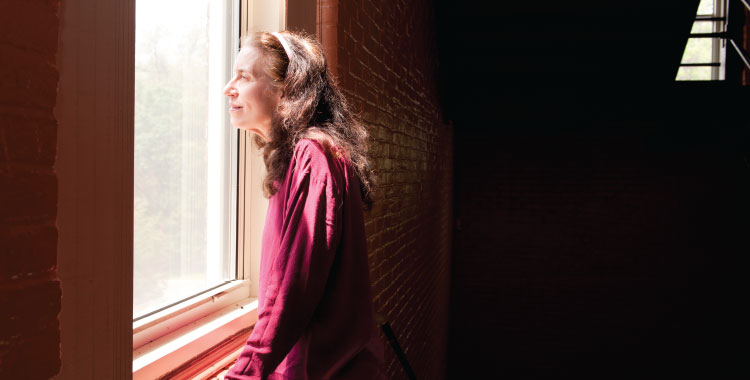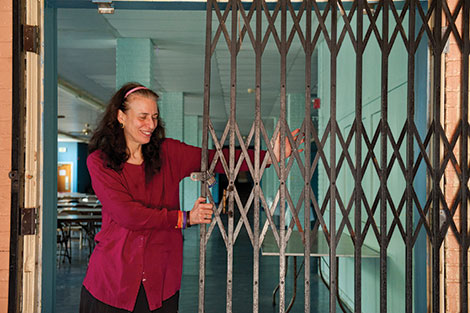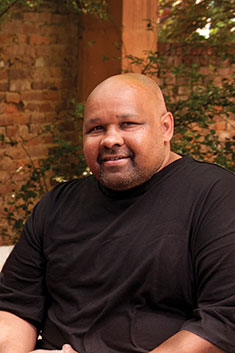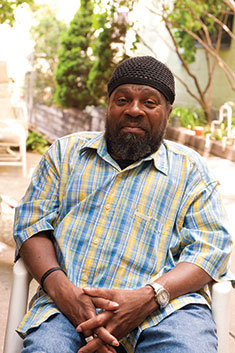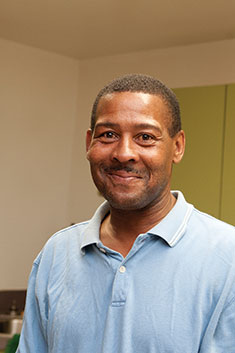UMBC alumna Mary Slicher founded one of Baltimore’s leading advocacy groups for the homeless forty years ago. Now her organization is finding a new home of its own.
By Elizabeth Heubeck ’91
With a discernible bounce in her loping gait, Mary Slicher ’73, sociology approaches the double doors of a formidable stone building that dates back to the 1950’s. A stubborn folding metal gate renders the building’s inside areas off-limits to intruders, and as Slicher pushes her weight against the gate and it finally slides to the side, she flashes a ready smile and tosses her long wavy black hair away from her shoulders.
It’s easy to imagine Slicher, 60, flashing that same quick smile on a night some 40 years ago as she stood outside the UMBC library at closing time with some of her fellow students. Back then, Slicher and her classmates talked excitedly about starting an organization that might help end homelessness in Baltimore.
Almost four decades after founding that group, which she and three fellow UMBC students called Project PLASE (People Lacking Ample Shelter and Employment), Slicher has kept both her youthful energy and her long-cherished ideals.
“You’re not whole without a home,” says Slicher.
Since its founding in 1974, Project PLASE has grown from a walk-in center for homeless citizens on the second floor of a St. Paul Street row house in Baltimore’s Charles North neighborhood into a nonprofit organization with 55 employees and an operating budget of around $3.5 million that provides housing and a host of related support services to 450 Baltimore residents annually.
Slicher’s belief in Baltimore’s homeless residents – even when they themselves, or the community at large, seem to have stopped believing – has endured and grown over time. And now Project PLASE is also on the cusp of an expansion into a new space in Southwest Baltimore that will increase the number of homeless residents it serves.
With Project PLASE’s growing waiting list of 338 people and a startling 19 percent increase in homelessness in Baltimore between 2009 and 2012, Slicher recognizes the city’s dire need to provide housing and related services.
“Baltimore is in a unique position,” Slicher says. “We’re on some lists you wouldn’t want to be on: We have the second-highest rate of HIV in the country, and we lead the country in heroin incidents related to ER hospital visits. But all these things can be addressed with the right resources.”
Homelessness in Baltimore is a problem that has grown immensely in both size and complexity since Slicher first started Project PLASE.
Slicher says the seeds of her own pursuit of justice and social equality were planted in childhood. As a young girl, she would take the bus with her mother from their suburban home in West Baltimore to a downtown Baltimore that was still home to legendary high-end department stores like Hutzler’s and Stewart’s. En route, they would pass by public housing projects and her mother would become reflective, telling her daughter: “I would love to know their stories. Everybody’s got a story.”
As an advocate for the homeless, Slicher hasn’t simply yearned to know the stories of people living in challenging situations. She’s listened carefully, and, in many instances, she has made it possible for the homeless to change the arc of their own stories dramatically.
Slicher explains that trust is the key – and gaining the trust of someone who’s been living on the streets typically requires a lot of patience. “You might have to meet someone at McDonald’s for coffee ten times,” she says.
The complexity and interrelation of factors that force people into homelessness make the need for such patience understandable. Addiction, poverty, mental and physical illness, and isolation can all play a role in why someone ends up without permanent shelter. Project PLASE works to address these problems that lead to, or co-mingle with, homelessness.
Up front, the nonprofit provides the basics: transitional housing and food in a setting with around-the-clock support. Project PLASE also offers tailored services (all of which are voluntary) including case management, access to an on-site nurse and a mental health therapist, medication monitoring, HIV education, daily living skills, transportation, and referrals to medical and other services.
Those who know Slicher and her work well remark on her patience and her energy in attacking the problems faced by the homeless head-on.
“She’s one of the most incredible people I have known. The Baltimore community is so absolutely lucky to have someone that diligent, that driven, with the kind of tenacity and ability to understand and work with this group of folks,” says Gregory Hunter, a social worker and co-founder of Project PLASE who served as its first director before handing the reins to Slicher.
Hunter recalls that in its early days, when Project PLASE was located in a little room above the Manna House food pantry on St. Paul Street, which has since become a private home, they had little more to offer than a sympathetic ear.
Slicher, too, says the organization’s earliest days were filled with compassionate conversation to get to the root of a client’s problems. “We would just sit down and talk with people until they started to trust us, and themselves,” she recalls.
Envisioning clients’ potential for growth and change is the foundation of Slicher’s approach. Sometimes that means looking beyond alcohol on the breath, or the acute symptoms of mental illness that a homeless person is battling, or even a general brokenness of spirit, to grasp who a person once was and what he or she can become.
“Part of our job is to see someone broken and to imagine them whole,” she explains.
More importantly, the fact that Slicher and her colleagues at Project PLASE can see the potential in someone grappling with homelessness eventually helps the client see a path forward too – in his or her own time.
“At Project PLASE, I haven’t had no kind of pressure, like you have to have something done by this certain time,” says a client named BoneyBoney. “They meet you where your needs are,” he adds.
When Boney came to Project PLASE, he was fresh out of a months-long drug rehabilitation program. Saddled not only with a drug addiction that he was working hard to control, he also suffers from bipolar disorder, HIV and Hepatitis C.
“I was scared that when I left [rehab], I had nowhere to go,” Boney says. After working hard to get clean, he didn’t want to return to living in abandoned buildings in Baltimore City, where he squatted for five years before entering drug treatment.
Boney has been a client of Project PLASE for 15 months. In that time, he’s stayed clean. He lives in temporary housing provided by Project PLASE, and has immersed himself in the community life the nonprofit offers. (He has even served as chairman for events put on by the consumer advisory board, including holiday gatherings for the residents.)
As Boney waits f
or an opening in permanent housing, he busies himself by working on obtaining his general equivalency diploma, or GED. “I’ve been in and out of drug programs, rehab centers, psych wards. I never been anywhere that helped me like here,” Boney says. “Miss Mary’s always willing to stop, talk, listen to you, ask how things can get even better.”
Jerry Morris echoes Boney’s sentiments. He’s been a client of Project PLASE for almost 13 years, having heard about it from neighboring nonprofit Healthcare for the Homeless. When Morris approached Project PLASE, the words of his mother filled his head.
“I could hear her voice saying that she didn’t raise me to be a drug addict,” recalls Morris, who’s been clean since he’s been with Project PLASE.
Reflecting on why he’s been able to achieve long-term sobriety and stability, and thus make good on his mother’s words, Morris explains: “The people at Project PLASE, they were like a real good doctor. They asked me: How do I feel? What do I want?” He pauses before adding, “They renewed my hunger to satisfy my mother.”
Seeing a happier and healthier future for those served by Project PLASE is important. But over the past few years, Slicher has also been envisioning the possibilities for Project PLASE itself – and making them a reality.
Take, for instance, three empty buildings in Southwest Baltimore – one dating back to the 1890s and all sorely in need of repair and renovation – that will soon provide an expanded base of operations for the organization. Shuttered in 2010, these buildings on Old Frederick Road were owned by St. Joseph’s Monastery Parish, with one of the buildings used as a parochial school.
The prospect of restoring these buildings to their former glory or repurposing them into something entirely different would be daunting to many people. Not Slicher. During a tour of one of the buildings, Slicher points out its copious interior and the large windows that bring in lots of light. She can already see how these run-down and outmoded buildings could make the perfect home for those without one.
Slicher’s identification of the parish’s buildings as a new headquarters for Project PLASE – and the site of more transitional and permanent housing for the homeless – was only the first step. She needed the community surrounding the buildings to envision it as the ideal location, too.
That’s why Slicher led a year-long educational campaign in the residential communities surrounding the property. Without backing from local residents, the re-zoning that was required for Project PLASE to pursue its purchase simply wouldn’t have happened.
It was no small feat. Slicher knocked on doors in the Irvington and St. Joseph’s neighborhoods, working to win over residents who initially opposed welcoming formerly homeless people to their neighborhoods. She also enlisted some of the 80-plus members of St. Joseph’s Parish, which continues its mission in the neighborhood, to help her spread the word, and spoke at area community association meetings.
“Until you really dialogue with individuals, and let them know what your group is and what you can do, sometimes there are a lot of fears – some they can name and some they can’t,” says Slicher. “If you can dialogue with people, it really makes a difference.”
That dialogue eventually met with success. Once members of the surrounding communities were assured that the acquisition would provide a much-needed service to homeless residents—and also that the new residents would make good neighbors—the community got behind the purchase. With the support of Baltimore City Councilwoman Helen Holton and a host of community and civic leaders, the re-zoning was issued and Project PLASE had a new home.
Harry T. Spikes II backed the project from the start. A special assistant to Congressman Elijah E. Cummings, Spikes had a personal reason to support the expansion of services to Baltimore’s homeless population: His father experienced homelessness as a young boy. Spikes, as chairman of the Shelter Committee, part of the local nonprofit Community Assistance Network Inc., spoke before Irvington community members to ensure them of Project PLASE’s good intentions. “I shared with them my passion for helping people who just need a shot, like my dad did,” he says.
Spikes also stood before that audience because he believes in Slicher. “There’s not a lot of Marys out there. She’s walking the walk,” he says. “I’m so happy she’s doing what she’s doing.”
When renovations at the Old Frederick Road site are complete, Project PLASE will consolidate some of its existing housing units and offer new, improved ones. Forty housing units will remain in the current headquarters, at 1814 Maryland Avenue, but existing buildings on St. Paul Street and North Avenue will be sold to focus on the renovations at the new site, which will boast 62 one-bedroom transitional housing units, 36 permanent one-bedroom apartments, and even space for a health suite, computer lab, commercial kitchen and dining area, plus counseling and meeting rooms.
The relocation of Project PLASE is envisioning writ large. But Slicher also revels in important details, like the private rooms that will enhance clients’ sense of personal dignity. “Clients will have private rooms. That will be so nice for them,” she observes.
Part of Project PLASE’s success can be found in not allowing a failure to permanently damage a future. Unlike many other agencies that aim to help homeless people in need, especially individuals who suffer from problems of addiction (an estimated 64 percent of all homeless people have alcohol or substance abuse problems, according to the National Coalition for the Homeless), Project PLASE gives its clients a second chance.
“If I went into a treatment program for substance abuse, relapsed, and tried to come back, I couldn’t,” Slicher says. Most drug treatment programs operate with a zero-tolerance policy.
Slicher points out that this is not the case at Project PLASE. While it is imperative that clients in its transitional and permanent housing programs stay clean, those who fail to maintain sobriety are not permanently banned from the program. In fact, if clients are asked to leave because they’ve begun using drugs or alcohol again, they actually rise to the top of the waiting list when they return to Project PLASE at a later time.
“It’s 100 percent love in Mary’s heart. All she do is help,” says Carlton Gross, a trim man with a twinkle in his eyes and an irrepressible smile who understands the need for second chances.
In his twenties, Gross, a single father, owned his own house and also a cafe. Then he got hooked on cocaine and heroin and lost it all. He lived on the streets for six years. After completing an in-patient, six-month drug program, he knew he wasn’t ready to stay straight on his own. “I was going to get high if I went back on the street,” Gross says.
Fortunately, a social worker referred Gross to Project PLASE. He’s been a client for the past six years. “They help you with small-time goals so you can move on to big-time goals,” says Gross, who started his ow
n landscaping business last year. “I see where I’m going. I had my own house. I want to get that back.”
Slicher is quick to defend her clients and underscore the incredible obstacles they have overcome to get to where they are. She doesn’t dwell on the low points in her clients’ lives. She’s focused on the whole person.
It’s a quality that shows itself even in small moments, such as a conversation with Mike Coram, a counselor at Project PLASE. When Coram mentions the trajectory of clients such as Carlton, he observes that they are “getting up from a fall” on their way to discovering greatness.
Slicher quickly interjects: “Mike, they’re already great.”
It helps that Slicher has had the opportunity to see clients not only at their most fragile, when they come to Project PLASE, but also when they’ve gotten back on their feet. “I see people all over the place – when I go to the Enoch Pratt, the Giant – who were homeless and no longer are. That’s the untold story of homelessness,” Slicher says.
It’s a story embodied in people like Boney, Gross, Morris, and the countless other clients who have arrived on the doorstep of Project PLASE seeking shelter after confronting the darkness of homelessness.
“Many in the community only see homeless persons in a negative light,” Slicher says. “Here at PLASE we are lucky enough to see the person, and their humanity, in its entirety—strengths and struggles all together—as any of us would want to be seen.”
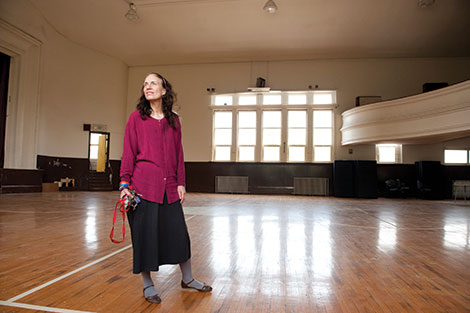 SIDE BAR: FACTS AND FACTORS
SIDE BAR: FACTS AND FACTORS
When Mary Slicher co-founded Project PLASE (People Lacking Ample Shelter and Employment) in 1974, she had a good idea at just the right time.
Scholars who study homelessness and poverty note that average wages have fallen 16 percent – after adjusting for inflation – since 1973. And the mid-1970s also marked the onset of increasing scarcity in affordable housing.
While statistics on homelessness in the 1970s are difficult to come by, it is likely that far fewer people in Baltimore were without homes in that decade. Conservative estimates place 4,088 men, women, and children on the streets of Baltimore on any given night in 2013. Some say that number may be eight to ten times higher, as those who conduct census counts rarely enter the 40,000-plus vacant homes in Baltimore which people without homes are known to occupy.
The following timeline offers a glimpse of the societal factors that have fueled homelessness since Project PLASE opened its doors.
- Late 1970s: A trend to de-institutionalize mentally ill patients formerly residing in psychiatric hospitals without adequate plans for transitional housing leads to a large increase in the homeless, mentally ill population.
- 1980s: Cuts to housing and social service programs push the homeless population upward. Homeless rates in American cities triple between 1981 and 1989, from 5 to 15 people per 10,000 residents. The arrival of crack cocaine in the mid-1980s also contributes to the soaring homeless rates.
- 1990s: Scores of public housing units, having fallen into disrepair and becoming dilapidated, are abandoned, leaving many without affordable housing options.
- Early 2000s: Federal public housing funding drops significantly, putting affordable housing out of reach for even more city residents. And a report on Baltimore’s homeless population, published in 2005, notes that almost 30 percent of the city’s homeless are veterans.
- Late 2000s: In 2008 and beyond, many people report being homeless for the first time, as unemployment due to the recession forces many out of their homes.
Sources: Mayor’s Office of Human Services; Health Care of the Homeless; Over the Edge: The Growth of Homelessness in the 1980s, by Martha R. Burt (Russell Sage Foundation and Urban Institute Press, 1991); Baltimore Homeless Services, Inc.; James T. Patterson, America’s Struggle Against Poverty: 1900-1994 (Cambridge: Harvard University Press, 1994).

